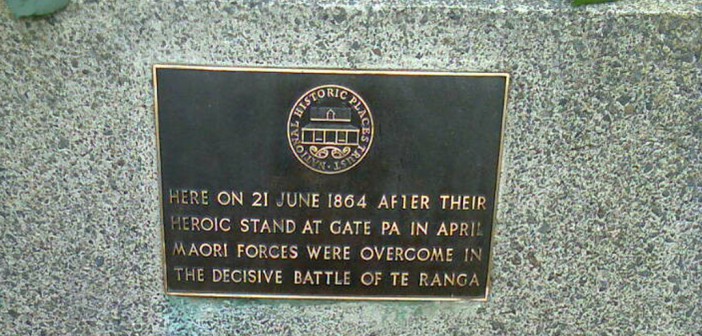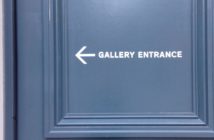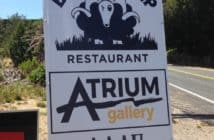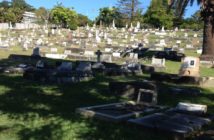“If I die, I die for the land”: A bus takes us from the battle site of Te Ranga, a newly fenced grassed area on the corner of Joyce and Pyes Pa Roads. It has to go quite a way down Joyce Road to turn and as we grind slowly back up the steep gully sides it’s evident why this narrow high ridge would be selected to establish a fortification. Under the huge Ngai te rangi tent tables are set with white linen and large red napkins. Lines of stainless steel bain marie and huge pots of porridge with cream produce a delicious breakfast for the crowd. If it wasn’t that we are commemorating a tragic event in local history you’d think we’d all gathered for a social picnic or festive day out. At the back of the tent are two of the huge image and story boards. In two simple paragraphs they describe what happened here. Today I think we would call it a massacre.
My day as usual had started through my kitchen window – cliched coal hard skies and diamond stars. No rain but I still wrapped up warm. I drive along the Moffat Road ridge and am once again reminded how much of Tauranga is fingerlike high hills and ridges stretching out to the sea.
Light glows down one side of the enormous and imposing pouwhenua on the corner of the site. There’s a good sized crowd on this cold, damp mid-winter morning. I’ve moved to the front so I can see and hear. The blessing begins. As the morning has lightened I can see the low and heavy grey rain clouds moving from the west. There is a small dull crescent moon. Above where we are standing a circle of pale blue appears and the crescent moon suddenly shines. In the sky to the left of moon and the pou, above the grey clouds is a large white fish it’s body shaped by small scale like white clouds. We then move to bless a second much smaller musket holding pou.
The morning programme commences after the breakfast. I’ve walked back in the company of a direct descendent of Taratoa. She tells me after this battle the remaining extended family moved to Otaki. Back on the grass the challenge party is having a final run through. I stand in the middle of the paddock and hear the names of the dead and the iwi recalled.
We are called on and challenged. As the oratory commences a horse truck and stream of cars go by – this site is adjacent to a main highway. A little girl in very brightly coloured winter clothing toddles in and among the at ease warriors. A tiny warrior with a piupiu over his trousers and gumboots is brought back to the seating by his nana. While the speeches continue the traffic keeps moving by. In one surreal moment a new and shiny coach with large MANA lettering and rear flags cruises up. One of the flags is at half mast.
It’s cold sitting stil. The lady next to me pulls on her gloves. Te Awanui Black, Wellington business suited and taiaha wielding speaks. It’s traditional oratory but of this time and this place. I hear him acknowledging names I know. The kuia sitting near me leans over every so often to translate. “welcoming us back – united as one people” . She tells me she married here but is”from over there”.
Uibelievably on this mid-winter morning a monarch butterfly slowly flies between the tents of the tangata whenua and manihere. The spokesperson for the kingitanga is an umbrella wielding orator . Over in the kapa haka group large new blue taurpaulins are being spread on the grass and the young people gratefully sit down. The oratory and speeches on this morning seem to be different from those at Pukehinahina. There’s laughter and raising of contemporary issues. A koha is placed and received. As the elderly gentlemen walk forward then back away I’m told that to turn your back would be an insult. Like state funerals, the Trooping of the Colour, the opening of Parliament there are long standing traditions and protocols to be observed.
We hongi – it’s a very long line. Now I’m sitting on the other side. My translator is sitting elsewhere. Representatives of the English and New Zealand armies are called on and I see the challenge party from the rear. The lines of women and children behind the frontline. The cold continues and I hear someone ask their children if they need to go home. Western Bay Mayor Ross Paterson is seated opposite among the military uniforms and a huge remembrance wreath. A naval officer speaks and tells us this was the final conflict in the land wars. He talks about the site in defence terms. How we now understand and have learned from our shared past. In my ears are words of one of the Pakeha visitors today – how disappointed she has been by some of the letters to local newspapers. I also remember the years of discrimination and institutionalised racism and the effort and time it has taken to obtain settlements. There are two more speakers. As local kaumatua Huikakahu Kawe speaks the sun comes out. Tom Roa speaks first in Maori and then in English telling those opposite “there has never been a surrender” and that outstanding issues still need to be discussed.
The most piercing part of the day is the performance re-enactment by children and young people of the events at Te Ranga. There is a formal church service and wreath laying. Out of the corner of my eye I notice one highly organised team has started to take the covers off their trailer ready to take down the site. Attending military personnel are having their photographs taken at the plated remembrance stone. A record for some of a once in a lifetime experience. Again, some of the children and young people present today, will be the organisers of the 200th commemoration. At lunch a young man from Matapihi asks me why I have attended – Quite simply, it is part of our shared local history.
PUKEHINAHINA Photo Exhibition Tauranga City library until the 29th July 2014, free during library hours. This is an exhibition of very large photographic images captured during the events which occurred earlier this year for the 150th commemoration of the Battle of Pukehinahina – Gate Pa on 29 April 2014. The photo boards are generally suspended from the ceiling around the library or attached to the large library supporting pillars. It’s an excellent way to showcase these images and to make them available to perhaps a wider range of the community than might go to see them as a gallery exhibition. They are however gallery exhibition quality and well worth taking the time to walk round the library.





